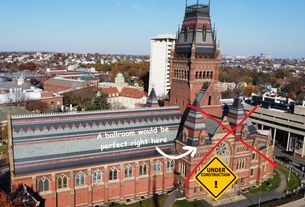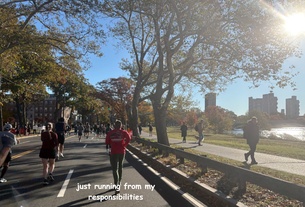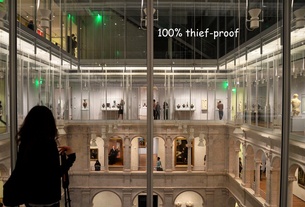{shortcode-2b94cd654c013950aee7c5982552eea1a24ad86a}
Under the leadership of an unconventional president, members of the Undergraduate Council mobilized this spring to challenge the priorities of a university currently engaged in an aggressive, multi-billion dollar fundraising drive with a public campaign of their own.
Fittingly titled “UC 250K,” the movement called on University President Drew G. Faust to grant the student governing body a six-figure increase in the pool of money it has available to fund the College’s roughly 400 student groups. The campaign culminated in a rally that drew a crowd of about 100 students who cheered on UC leaders shortly before they walked in to Massachusetts Hall to make their demands.
Harvard’s chief executive would not grant the UC’s request, and instead referred them to the deans within the Faculty of Arts and Sciences with direct control over its budget. And as UC leaders were shuffled from administrator to administrator, it became clear that the body most responsible for funding student organizations would not immediately be seeing a dime—let alone $250,000—of an increase to a budget that has been strained as the number of groups asking for funding has continued to rise.
This public clash between student leaders and administrators over the allocation of Harvard’s budgetary resources reflects a larger debate brewing over the proper place of extracurricular activities within the College’s educational model built on the values of the liberal arts. Administrators and faculty put forth a vision that prioritizes classroom learning as a means for undergraduates to cull critical thinking skills and develop a wide-ranging, rather than specialized, expertise.
While administrators maintain that what makes a Harvard education unique is the access to all-star faculty and vast academic resources, an increasing number of students say that something is missing. These students, seeking real-world skills, are opting to school themselves outside the classroom, charting their own educational courses and defining their undergraduate experiences on a thriving extracurricular culture in tension with Harvard’s institutional priorities.
A CULTURE OUTSIDE THE CLASSROOM
When students come to the College, one of their first opportunities to interact with upperclassmen is not in section, but at the fair that showcases the College’s extracurricular offerings. With Annenberg closed for dinner and peers eager to explore what opportunities await, freshmen trek to the Quad, only to be bombarded by flyers, hurried explanations of organizational missions, and requests to join email lists.
Few freshmen have the time or patience to stop at every booth at that fair. Today, there are 399 active, independent student organizations recognized by the College, according to Associate Dean of Student Life David R. Friedrich. That number does not include Harvard’s 65 club sports teams, the 86 student-directed service programs offered through the Phillips Brooks House Association, nor any groups that operate without official College recognition.
Over time, this number has steadily increased.
“It’s been a pretty tremendous increase,” Interim Dean of the College Donald H. Pfister says. “I would think probably in the last ten years there’s been 100 new student organizations.”
Student interest in particular groups has also grown. The Harvard College Consulting Group, for example, has seen a more than two-fold increase in the number of applications for membership it receives—from 105 in 2010-2011 to 339 this year—according to the group’s former director, Kenny A. Lee ’14. Likewise, the Institute of Politics, an umbrella organization composed of 13 undergraduate programs, saw a sharp increase in applications in the past year, according to President Eva A. Guidarini ’15.
{shortcode-149b61e2257230d288d6e720098b838236f27c57}
Large numbers of available extracurricular opportunities fuel a campus culture where heavy extracurricular involvement is the norm. Although freshmen are, with few exceptions, limited to a four-course academic load in the fall semester, students often join not one club when they arrive on campus, but four or five—or even 12. Rebecca J. Ramos ’17 says she joined 15 student groups her freshman year, among those three club sports teams, Harvard Model Congress, CityStep, the First-Year Social Committee, and the sorority Delta Gamma—on top of two jobs.
Not all students at Harvard are so involved in student groups, but for the most invested, participation means devoting more than a few hours to out-of-classroom commitments. According to Cyatharine M. Alias ’15, her active participation in various PBHA programs costs her about half her time every week, with the rest of that time devoted to her personal life and her schoolwork. Guidarini says she spends 40 or 50 hours weekly working for the IOP, and she thinks about it “every minute.” She calls her role as the organization’s top student leader a “full-time job.”
THE VALUE ADDED
Across the board, students immersed in the College’s extracurricular culture point to the opportunity to build friendships based on shared interests and develop leadership skills as they collaborate with their peers as reasons for participating in student groups.
Brett M. Biebelberg ’16, a UC representative who also participates in first responder organization CrimsonEMS, says that student groups fill a need for social opportunities created by Harvard’s lack of a large Greek scene that is present on other college campuses. Other students add that they derive much of their social lives from the students they meet in various groups.
“One of the big drivers of [selecting extracurriculars] are whether or not [students] feel they’re making friends in the activity and whether they feel like they have a strong affinity for the people they’re meeting,” says Thomas S. Wooten ’08, a tutor in Quincy House and Ph.D. candidate in the Sociology Department who is currently researching extracurricular life at Harvard.
Wooten adds that, for some students, extracurricular life seems to be “supplanting social life with a blocking group or social life in a House.”
Beyond the social opportunities, members of student groups learn practical skills by working with peers, planning meetings, and networking while pursuing a passion, they say. The desire for applicable, real-world skills can push students to seek leadership experience in the ranks of one of many existing groups—and if they don’t like their options, they create their own.
UC President Gus A. Mayopoulos ’15, who served as president of the humor publication Satire V before he led the UC’s charge to demand that administrators increase funding for student groups, highlights negotiation as one of the many skills he has developed through extracurriculars.
Ziyao “Eric” Wang ’15, co-president of the Harvard-Radcliffe Chinese Students Association, adds that through extracurriculars, he has learned “how to be a leader, how to manage, how to think about structural and organizational questions, how to build a network,” among other skills. Wang has been involved in a number of other groups, such as Harvard Student Agencies and the Harvard China Forum.
‘THIS IS AN ACADEMIC INSTITUTION’
While administrators and faculty largely acknowledge the educational and social value of participating in student groups, they maintain that students’ commitments to the classroom should and must remain their top priority.
"One thing that we know is that students who participate in activities will get more out of their college experience,” says Friedrich, who at the Office of Student Life oversees the registration process for student groups.
But Friedrich, like many of his colleagues, expresses the concern that some students may be having trouble balancing their extracurricular commitments with academics. “Academics do need to come first,” he says. “They are the priority here.”
History professor James T. Kloppenberg says extracurricular activities are valuable—but only if they are truly “extra” curricular, meaning that they do not supercede commitment to the academic realm.
“They should understand that they’re here to get an education, not to join 15 clubs,” adds Harry R. Lewis ’68, a computer science professor and former dean of the College.
As more organizations are created—43 of the College’s 399 groups were recognized this year, according to Friedrich—administrators and faculty worry that with meetings to attend and conferences to run, students are forgoing the chance to dive into a liberal arts curriculum in favor of fulfilling their out-of-class obligations.
“Students now have more things to do than time. So how do you calculate what you aren’t going to do and what you are going to do?” Associate Secretary of the Administrative Board Brett Flehinger asks. “With extracurriculars...you’ve got an obligation to other people, so if you’re in the leadership in a group or club and you’re running short on time, you still might feel committed to do that.”
Flehinger adds that it is not “uncommon” for students who go before the Ad Board, either for poor grades or allegations of academic dishonesty, to cite overcommitment to extracurriculars as a reason for their academic performance or actions.
Many administrators say they worry that heavy extracurricular involvement is adding unnecessary stress to students’ lives. Others share the concern that students are using their time at Harvard not to deeply engage with ideas, but to add bullet points to their resumes.
“You’ll be 22 when you graduate, you’ll be 70 when you retire, you have 48 years to work on your profession—you have four years at Harvard,” says History professor Charles S. Maier ’60. “You shouldn’t be using your four years to be adding to your 48 years for your profession.”
OUT OF THE BOOKS, INTO THE SUITS
By and large, the students who are most invested in student groups do not contest that even though they enjoy their classes, they have chosen to prioritize extracurriculars. Where their viewpoints differ from those of administrators is that they argue that their education directly benefits from this decision.
{shortcode-214a6bdc729b6eee243c89fe6b18313370e3c241}
Driven in part by the desire to develop real-world skills that they say are difficult, if not impossible, to develop in a traditional liberal arts classroom, these students turn to extracurriculars for what they describe as a more engaging learning experience than the classroom.
“I've never had to manage people in a classroom setting,” Mayopoulos says. “Extracurriculars provide you with all of these opportunities that don't really have any other place to occur at Harvard.”
Although some professors, like Maier, decry this devotion to pre-professional pursuits, extracurricular involvement takes on special significance for students looking to gain the skills necessary for professional careers.
Ryley R. Reynolds ’15, president of HSA, says she chose Harvard over Wharton, the University of Pennsylvania’s business school, precisely to participate in the College’s extracurriculars. Reynolds says she had planned to attend Wharton, but at Visitas, some students at HSA asked her: “Why learn about business when you can actually run a business?” That opportunity—not Harvard’s academics—prompted her to change her mind.
Reynolds is not alone. Many students say they choose to come to Harvard with extracurricular opportunities in mind, and when they arrive, some go as far as to say that they learn more from their experiences outside of the classroom than in it.
“I’m much more passionate about finding a way to make the Harvard China Forum better than trying to figure out how to make my p-set better,” Wang says. “I do both, but I’m more passionate about the former.”
Critical faculty members suggest that students might be less likely to prioritize extracurriculars over the classroom if courses were more rigorous, engaging, or both. Many students say that their extracurricular commitments are actually more challenging than their academics, because peers keep them accountable for doing their work.
“I blame the faculty,” says Government professor Harvey C. Mansfield ’53. “If you get an easy A, there’s no way you’re going to work as hard as if you don’t.”
The academic literature lends credence to this sentiment. According to a paper by sociology professor Christopher Winship, grade inflation in higher education could help explain why the amount of time students spend studying has decreased by 50 percent in the last four decades.
TWO ROADS DIVERGE
The spring’s UC campaign for student funding was, in a sense, demonstrative of conflicting views about the importance of the parts of a Harvard experience.
“When it comes to where you are putting your money, the administration has shown very clearly that they don't see [extracurriculars] as a priority for students," Mayopoulos says.
And while, as reflected in its capital campaign priorities, Harvard continues to reaffirm its identity as an academic institution built on a tradition of teaching and learning, some students still define their undergraduate experiences by their time outside of class. They instead opt to go down their own paths to an undergraduate education, learning from peers more often than books.
“I will always define my experience at Harvard looking back based on the extracurriculars that I did, not necessarily the class work that I did,” Guidarini says. “I love my classes, but the bulk of my life—my social life, my time, my involvement—has been in extracurricular activities, and I think that’s always how I’ll define my time at Harvard.”
—Staff writer Madeline R. Conway can be reached at mconway@thecrimson.com. Follow her on Twitter @MadelineRConway.
—Staff writer Steven S. Lee can be reached at steven.lee@thecrimson.com. Follow him on Twitter @StevenSJLee.


